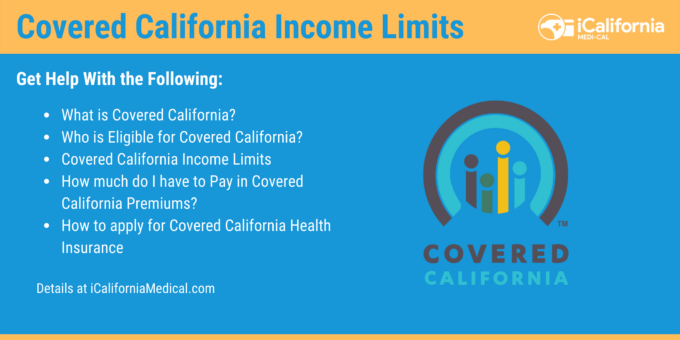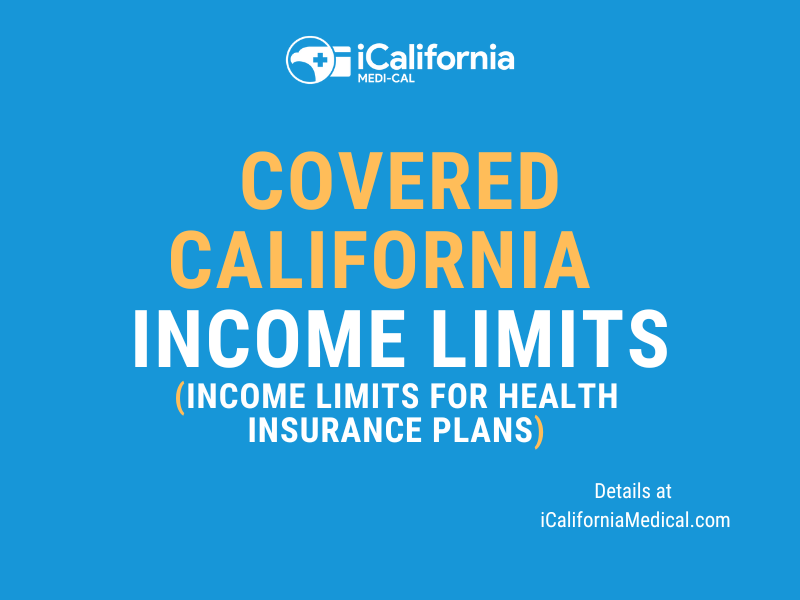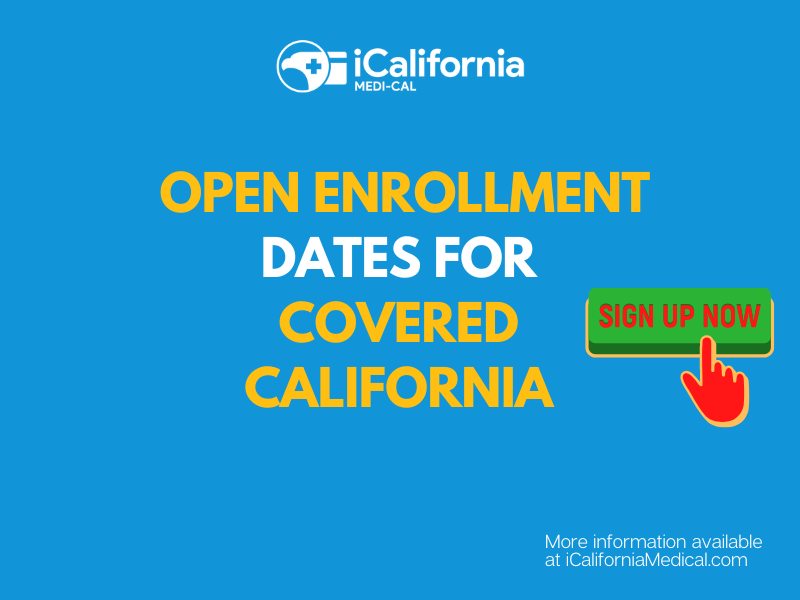If you are not eligible for California Medi-Cal and have been asked to apply for Covered California, or you currently have coverage and want to know the Covered California Income Limits for 2022, we can help. Here are some of the questions this post will answer:
- What is the income threshold for Covered California?
- Is everyone eligible for Covered California?
- How is income determined for Covered California?
- How much do I need to make to be eligible for Covered California?
If you would like answers to the questions above and more, continue reading below for the Covered California Income Limits chart for 2022 and how to apply.

Table of Contents:
- What is Covered California?
- Eligibility for Covered California Health Insurance
- 2022 Federal Poverty Levels
- Federal Poverty Level and Health Insurance Coverage in California
- Covered California Programs Income Limit Guide
- Covered California Income Limits – 2022
- How much do I have to Pay in Covered California Premiums?
- How to apply for Covered California Health Insurance
What is Covered California?
The Covered California Health Exchange is the government agency offering subsidized Obamacare plans in the state of California.
Covered California was created to assist citizens and legal residents with applying for marketplace coverage in order to comply with the Affordable Care Act (“ACA”).
When the law ACA was passed in 2010, each of the 50 states had to decide to either create a state-run health insurance exchange or offer enrollment through a federally-operated exchange.
This state of California chose to create its own exchange and called it “Covered California”.
What the Covered California Exchange Does
The Covered California Exchange helps Californians comply with the Obamacare mandate.
It helps individuals and families obtain health coverage that includes the minimum essential benefits required by the law.
Certain health care providers are certified to offer subsidized health and dental plans through the Exchange.
For people with a household income that is below 400% of the Federal Poverty Level (“FPL”), Covered California may qualify them to receive financial assistance, also called a “Subsidy”, which reduces their premium.
Additionally, if income is between 138% and 250% of the FPL, the State Exchange may also qualify individuals for extra discounts that reduce their cost of medical services.
Eligibility for Covered California Health Insurance
To determine your eligibility for Covered California benefits, you have to know whether your household income meets the income limit requirements.
Covered California income limits are calculated as a percentage of the Federal poverty levels.
Each year, the United States Department of Health and Human Services (HHS) issues the Federal poverty levels (FPL) guidelines.
The FPL is used to determine your eligibility for certain programs and benefits, including savings on Marketplace health insurance (like Covered California) and Medicaid and CHIP coverage.
2022 Federal Poverty Levels
The 2021 poverty level numbers were published on January 13, 2021, by the HHS.
Here is the FPL used to determine subsidy eligibility for all Covered California Health Insurance plans with 2022 effective dates.
| Persons in Family/Household | 2022 Coverage (2021 Poverty Levels) |
| For individuals | $12,880 |
| For a family/Household of 2 | $17,420 |
| For a family/Household of 3 | $21,960 |
| For a family/Household of 4 | $26,500 |
| For a family/Household of 5 | $31,040 |
| For a family/Household of 6 | $35,580 |
| For a family/Household of 7 | $40,120 |
| For a family/Household of 8 | $44,660 |
| For a family/Household of 9+ | Add $4,540 for each extra person |
Federal Poverty Level and Health Insurance Coverage in California
Here’s how the federal poverty levels (FPL) are used to determine eligibility for reduced-cost health coverage in California:
Income above 400% FPL
If your income is above 400% FPL, you may now qualify for premium tax credits that lower your monthly premium for a 2022 Covered California health insurance plan.
Income between 100% and 400% FPL
If your income is between 100% and 400% FPL, you qualify for premium tax credits that lower your monthly premium for a Covered California health insurance plan.
Income at or below 150% FPL
If your income falls at or below 150% FPL and you’re not eligible for Medicaid or CHIP, you may qualify to enroll in or change Covered California coverage through a Special Enrollment Period.
Income below 138% FPL
If your income is below 138% FPL, you qualify for Medicaid (Medi-Cal) based only on your income as part of the California Medicaid expansion.
Income below 100% FPL
If your income falls below 100% FPL, you probably won’t qualify for savings on a Covered California health insurance plan or for income-based Medi-Cal.
Covered California Programs Income Limit Guide
Here are the income guidelines for Covered California Plans based on a percentage of the FPL.
| Covered California Programs Income Limit Guide | |
| Federal Premium Tax Credit Eligibility | 100%–400%+ FPL |
| Silver 94 | 100%–150% FPL |
| Silver 87 | over 150%–200% FPL |
| Silver 73 | over 200%–250% FPL |
| AIAN Zero Cost Sharing | 100%–300% FPL |
| AIAN Limited Cost Sharing | 300%+ FPL |
| Note: Covered California uses FPL limits from the previous year to determine eligibility for its programs. |
|
Covered California Income Limits – 2022
The Covered California income limits require consumers to have a household income that ranges from 0% to 400% of the Federal Poverty Level (FPL) in order to qualify for assistance on a government health insurance plan.
What is the maximum Income to qualify for Covered California?
For 2022, here are the thresholds:
- Single Person – $19,320
- Household of 2 – $26,130
- Family of 3 – $32,940
- Family of 4 – $39,750
Here’s the complete list of Covered California Income Limits for 2022 based on household size based on the federal poverty levels above.
Note that the table below also includes Medi-Cal programs for comparison.
|
Covered California Programs (If ineligible for Medi-Cal)
|
Plans that qualify for Premium Assistance (Tax credit continues beyond 400% of FPL) | ||||||||||
| American Indian/Alaska Native (AIAN) Zero Cost Sharing Plans | AIAN Limited Cost Sharing | ||||||||||
| Silver 94 (100%-150% of FPL) | Silver 87 (> 150%-200%) | Silver 73 (> 200%-250%) | |||||||||
| Persons in Family/Household | 0% | 100% | 138% | 150% | 200% | 213% | 250% | 266% | 300% | 322% | 400% |
| For individuals | $0 | $12,880 | $18,755 | $19,320 | $25,760 | $28,947 | $32,200 | $36,150 | $38,640 | $43,760 | $51,520 |
| For a family/Household of 2 | $0 | $17,420 | $25,268 | $26,130 | $34,840 | $39,001 | $43,550 | $48,705 | $52,260 | $58,959 | $69,680 |
| For a family/Household of 3 | $0 | $21,960 | $31,782 | $32,940 | $43,920 | $49,054 | $54,900 | $61,260 | $65,880 | $74,157 | $87,840 |
| For a family/Household of 4 | $0 | $26,500 | $38,295 | $39,750 | $53,000 | $59,108 | $66,250 | $73,815 | $79,500 | $89,355 | $106,000 |
| For a family/Household of 5 | $0 | $31,040 | $44,809 | $46,560 | $62,080 | $69,162 | $77,600 | $86,371 | $93,120 | $104,554 | $124,160 |
| For a family/Household of 6 | $0 | $35,580 | $51,323 | $53,370 | $71,160 | $79,215 | $88,950 | $98,926 | $106,740 | $119,752 | $142,320 |
| For a family/Household of 7 | $0 | $40,120 | $57,836 | $60,180 | $80,240 | $89,269 | $100,300 | $111,481 | $120,360 | $134,951 | $160,480 |
| For a family/Household of 8 | $0 | $44,660 | $64,350 | $66,990 | $89,320 | $99,322 | $111,650 | $124,036 | $133,980 | $150,149 | $178,640 |
| For a family/Household of 9+: add | $0 | $4,540 | $6,514 | $6,810 | $9,080 | $10,054 | $11,350 | $12,556 | $13,620 | $15,199 | $18,160 |
|
Medi-Cal Programs
|
Medi-Cal for Adults | Medi-Cal for Pregnant Women | Medical Access Program (For Pregnant Women) | ||||||||
| Medi-Cal for Kids (0-18 Years) | CCHIP (for San Francisco, San Mateo, and Santa Cruz county residents) | ||||||||||
A New Limit on Health Insurance Costs
By federal law, no one eligible for our Covered California health coverage will have to pay more than 8.5 percent of their overall household income for health insurance.
This rule applies to all plans except those who choose to sign up for a plan with richer benefits, like a Gold or Platinum plan.
Additionally, people with lower incomes will pay a lot less than the 8.5% cap.
Also, those with higher incomes will see more savings than ever before under this new limit.
How much do I have to Pay in Covered California Premiums?
Here are the limits on premiums for Covered California health plans based on income.
| Household FPL Percentage | Percentage of Household Income to be paid for Covered California Premiums |
| 0-150% of FPL | 0% of household income |
| 150-200% of FPL | 0-2% of household income |
| 200-250% of FPL | 2-4% of household income |
| 250-300% of FPL | 4-6% of household income |
| 300-400% of FPL | 6-8.5% of household income |
| 400+% of FPL | 8.5% of household income |
Apply for Covered California
There are four ways to apply for Covered California Coverage:
Online
The fastest way to apply for Covered California coverage is online.
Applying online takes about an hour from start to finish. Click here to be taken to the website.
Apply With a Certified Enroller
There are hundreds of enrollment centers and thousands of certified enrollers statewide.
Make an appointment to get free help signing up for a Covered California plan. Click here to find an enrollment center or agent.
By Phone
To enroll by phone, call Covered California at 1- (800) 300-1506 ((TTY: 1-888-889-4500).
Service Center Hours are Monday to Friday, 8 a.m. to 8 p.m., and Saturday, 8 a.m. to 6 p.m. (Sunday: Closed)
You’ll get a call from a certified enroller, usually within 30 minutes.
By Mail
Click here to download the application.
You can mail your completed and signed application to:
Covered California
P.O. Box 989725
West Sacramento, CA 95798-9725
Or mail it to your local county office.
Covered California Income Limits Summary
We hope this post on Covered California Income Limits was helpful.
Questions?
If you have further questions about Medi-Cal, please let us know in the comments section below.
Be sure to check out our other articles about Medi-Cal and California Medicaid program, including:


